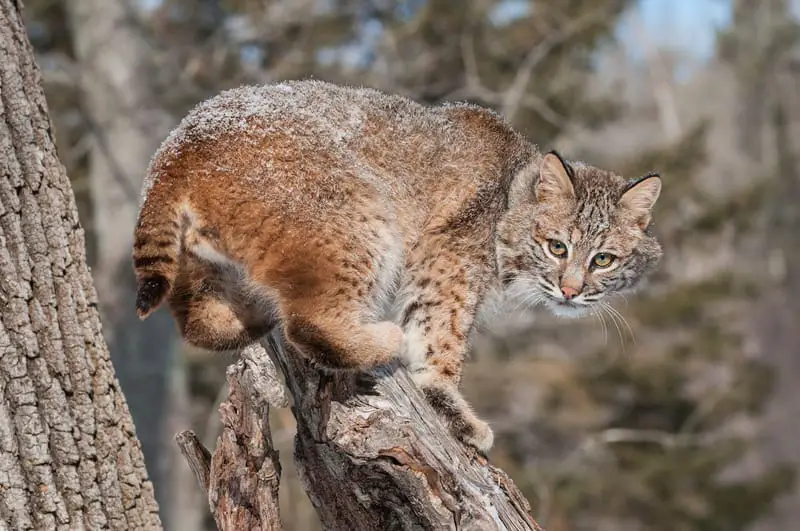According to the Alabama Department of Conservation and Natural Resources, the state has two native species of wild cats. These are the bobcat and the mountain lion. However, the mountain lion has been expatriated from Alabama since the mid-1900s. Consequently, the bobcat is Alabama’s only existing wild cat.
The Alabama Department of Conservation and Natural Resources website also says that there are rare sightings of Jaguarundis in central and southwestern Alabama, as well as adjacent states. However, they do not believe that there is or ever has been a breeding population of these small wild cats within the state of Alabama. We’ll talk more about Jaguarundis further down in this article
One last wild cat that may or may not exist in Alabama is the black panther. Wildlife officials do not believe in their existence. However, people in Alabama, as well as many other southeastern states, keep reporting black panther sightings. We’ll talk more about black panthers towards the bottom.
Bobcats in Alabama (Lynx rufus)
Bobcats are exclusively North American wild cats and are also the most common wild cat species in North America.
Aside from feral cats, they are the only wild feline predator with a breeding population in the state of Alabama.
Some other names for the bobcat are bay lynx, red lynx, and swamp devil.
Biologists believe that both the bobcat and the Canada lynx are descendants of the Eurasian lynx, and their ancestors crossed into North America via the Bearing Sea land bridge.
Where do bobcats live?
These small wild cats live in three North American countries. Their range begins in southern Canada and then extends south through most of the United States and down into central Mexico.
Compared to Canadian lynx, which thrive in deep snow country, bobcats struggle more in the snow due to the fact that they cannot walk on top of it like lynx can. A lynx’s huge paws function like snowshoes keeping it on the snow’s surface. On the other hand, compared to lynxes, bobcats have small feet that tend to sink into the snow. Bobcat tracks are about half as wide as lynx tracks. If the snow is too deep and powdery, it reduces their mobility along with their ability to catch prey. This is why the bobcat range dies out in southern Canada from there on north, Canada lynx are more prevalent and bobcats, less so.
In Alabama, Bobcats inhabit a variety of habitats like heavily wooded uplands, bottomland forest, brushy areas, swamps, and semi-open farmland. They are most likely, though, to inhabit prefer rocky outcrops and canyons.
These cats are mostly crepuscular or nocturnal animals, but it’s not uncommon to see one out and about in the daytime because they only sleep for 2 to 3 hours at a time.
Bobcats are solitary animals with the exceptions of during mating season or when a female is raising young. They are territorial and live in home ranges that they patrol and scent mark with urine and feces.
The size of a bobcat’s home range varies with the geography and the availability of food sources. It also is influenced by the sex of the animal. For example, adult male bobcats have larger home ranges than adult females.
One more thing about home ranges is that adult males and adult females sometimes have overlapping ranges.
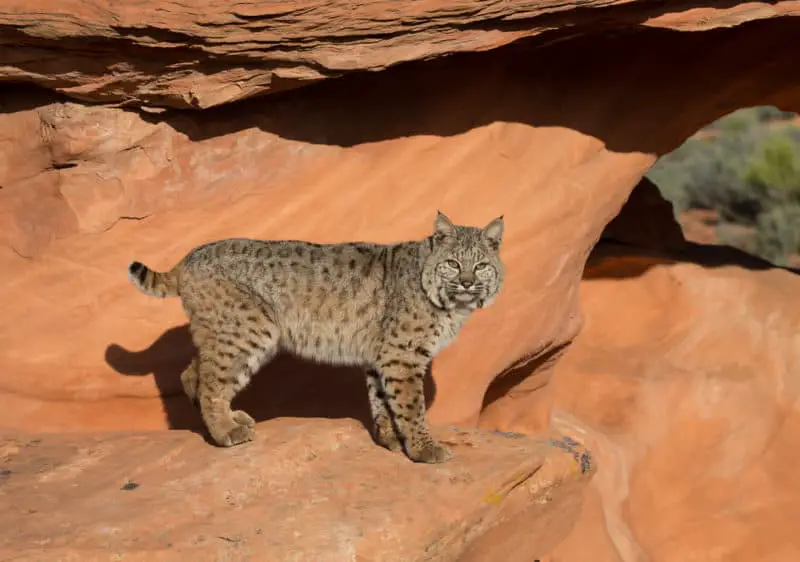
What do bobcats look like?
Adult bobcats are about twice the size of domestic cats. A domestic cat has a longer tail than a bobcat, though. Bobcats are 2 to 4 feet long with proportionately long legs.
Male Alabama bobcats are roughly 39 inches in length and weigh 20 to 30 pounds. On the other hand, a female bobcat weighs 10 to 25 pounds.
These animals have a “bobbed,” short tail with black bands on their upper surface. The tip of the tail is black on its upper surface but not the back. Their fur is usually gray to brown, with mottled black spots interspersed with black lines on their bodies. They also have black stripes on their inner forelegs and tail.
From a side view, you will notice that a bobcat is slightly higher at the rump than at the shoulders. Bobcats and lynx have long hind legs in proportion to their forelegs.
Bobcats have black-tufted, proportionately large ears. In other words, they have short ear tufts of hair that poke up above their ears that are black at the tips. They have black ears with white spots in the center of each ear’s backside. This gives the impression of a false eye on the back of each ear.
They also have a whiskered face that seems broader due to their long ruffled facial hair and whiskers. Their eyes are yellow with round black pupils.
Black bobcats
Melanistic color phase or black bobcats also exist in the wild. A melanistic bobcat is not solid black but has the same color patterns that a regular bobcat has. Its markings are dark black over a dark grey background. Here is a somewhat grainy video of a black bobcat in Blount County, Alabama.
What do bobcats eat in Alabama?
Despite its comparatively small size, the bobcat is an aggressive, tough, formidable predator. At times, they take down large prey that is several times bigger than they are, such as wild hogs and white-tailed deer. However, their regular diets mainly consist of small mammals such as eastern cottontails, eastern gray squirrels, fox squirrels, and assorted rodents. They also eat birds, such as the wild turkey, pheasants, and various songbirds, reptiles, insects, and carrion. When they take up residence in close proximity to a residential area, their menu might occasionally also include domestic animals, such as stray cats, small pets, and/or small livestock, such as goats or chickens.
They depend on their keen eyesight and sense of hearing to help them locate prey.
Bobcats are the definition of opportunistic predators and will prey on whatever wild animals are most plentiful.
Bobcats even use venomous snakes as a food source when the opportunity arises despite not being immune to the venom. They accomplish this by using their quickness to pin the snake’s head down with a paw, after which they dispatch the snake with a quick bite to its spine behind the head.
Alabama has a bunch of venomous snakes. They are the Southern Copperhead, the Northern Copperhead, the Florida Cottonmouth, the Eastern Cottonmouth, the Western Cottonmouth, the Eastern Diamondback Rattlesnake, the Timber Rattlesnake, the Dusky Pygmy Rattlesnake, the Western Pygmy Rattlesnake, the Carolina Pygmy Rattlesnake, and the Eastern Coral Snake. See
Reproduction and life cycle for bobcats
In Alabama, Bobcats mate anywhere from mid-winter through spring. The peak of the breeding season runs from December to late February. During the breeding season, a male bobcat may mate with multiple females. If they successfully mate, the gestation period for bobcats is 60 days.
After breeding, the male and female go their separate ways. The female takes all responsibility for the selection of a den site and the rearing of the young. Females generally give birth between late April and early May. See
Look for maternal dens in a wooded area. Bobcats use features such as rock outcropping, Hollow trees, openings in the ground, the root masses of overturned stumps, or the space beneath a fallen tree as denning sites.
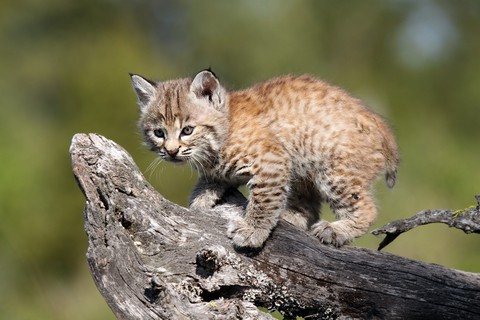
The average bobcat litter size is 3 kittens. Bobcat kittens are born with their eyes sealed, just like domestic cats are. However, their eyes will open when they are a week to 10 days old. By the time they are 2 months old, they will have replaced their spotted baby fur with a haircoat similar to what their parents have.
By mid-July, the kittens begin to venture out with the mother bobcats to fine-tune their survival skills. Their training may last into the early winter. By mid-winter, the kittens strike out on their own.
Female bobcats reach sexual maturity at 1 year of age, while males reach sexual maturity at age 2.
The average life span of a wild bobcat is 7 to 10 years. See
Bobcat hunting in Alabama
- Bobcats are classified as furbearers in Alabama.
- In Alabama, a license is required to hunt bobcats.
- There is no daily bag limit and no closed season.
- Hunting is only allowed during daylight hours.
- All bobcats and otters, regardless of the method of harvest, must be tagged by a representative of the Alabama Division of Wildlife and Freshwater Fisheries within 14 days of harvest.
- It shall be unlawful for any person to hunt or attempt to hunt within 100 yards of any dwelling belonging to another, whether occupied or not, without the permission of the owner or lessee of said dwelling.

Mountain lions in Alabama (Felis Concolor)
Mountain lions are large cats that are spread over a large geographic area that covers parts of all three American continents. Consequently, they have many regional names. In 1834, their scientific name was even changed from Felis concolor to Puma concolor. Some common names that mountain lions go by are cougar, panther, painter, and puma.
What do mountain lions look like?
A Mountain lion looks like a giant house cat with short tan hair. One of these animals is much bigger than a domestic cat, though. They generally have lean, muscular bodies, rounded heads, and upright ears that are oval at the tip. They also have a long tail, which is tan with a black tip. Their tail accounts for almost one-third of their entire length. Their long tails help them keep balance.
Mountain lions have a light brown coat of short, coarse hair over most of their body. The area around their nose, the tip of their tail, and the tips of their ears are black. Their belly, the area above their upper lip, lower lip, and chin are all white. They also have a sprinkling of dark hair on their backs. Bear in mind, though, that their coat color varies somewhat with geographic location.
Male and female mountain lions are phenotypically identical in every respect except for size. Males are 30 to 40% bigger than females. Though sizes vary considerably throughout the cat’s geographic range, an adult male or tom typically weighs between 110 and 180 pounds, 50 to (82 kgs). A rare few of them grow bigger than 200 pounds (91kgs). Female mountain lions or queens average between 80 and 130 pounds (36 to 59 kgs). Adult males or toms will reach 6 to 8 feet (1.8 to 2.4 M) from their snout to the tip of their tail. On the other hand, adult females are 5 to 7 feet long (1.5 to 2.1 M).
Mountain lions are the third largest wildcat in the world. They are also the second largest wild cat in the western hemisphere. They are smaller in size only than the Jaguar in the Americas. However, worldwide, the African Lion and the Tiger are also larger.
A fun fact is that despite their large size, they are not taxonomically classified as big cats because they cannot roar. Leopards, for example, are smaller than mountain lions, but since they can roar and cannot purr, they are classified as big cats, while mountain lions are not. Another interesting thing that I can mention here is that mountain lions purr.
Since they purr and cannot roar, mountain lions are in the Felis genus. Meanwhile, big cats, such as the African lion, tigers, leopards, snow leopards, and jaguars which cannot purr and can roar, are in the Panthera genus. “A side note, I listed snow leopards separately from leopards because they are a separate species.”
Where are they typically found?
Mountain lions live on all three American Continents. Their range begins in the Yukon territory of Canada in the north and extends down through parts of North America, Central America, and South America to Argentine Patagonia in the south.
The biggest populations in Canada are in British Columbia and Alberta. On the other hand, in the United States, they mainly live in the western states. Cougars are extinct east of the Mississippi river, aside from a small population in south Florida. The people of Florida call this elusive cat the Florida Panther.
Mountain lions are native to Alabama, whether they were representative of the eastern cougar or the Florida panther. In most quarters, it is agreed that the mountain lions in Alabama were Florida panthers.
The last confirmed cougar killed in Alabama was around 1948 in St. Clair County. In 1961, a track confirmed to be made by a cougar was found in Clarke County. Also, in the late 1960s, another cougar track was found in the same general area. What’s more, in the late 1960s, an Alabama conservation enforcement officer found a cougar den with cubs in Baldwin County. See
These are the last confirmed Alabama cougar or cougar track sightings.
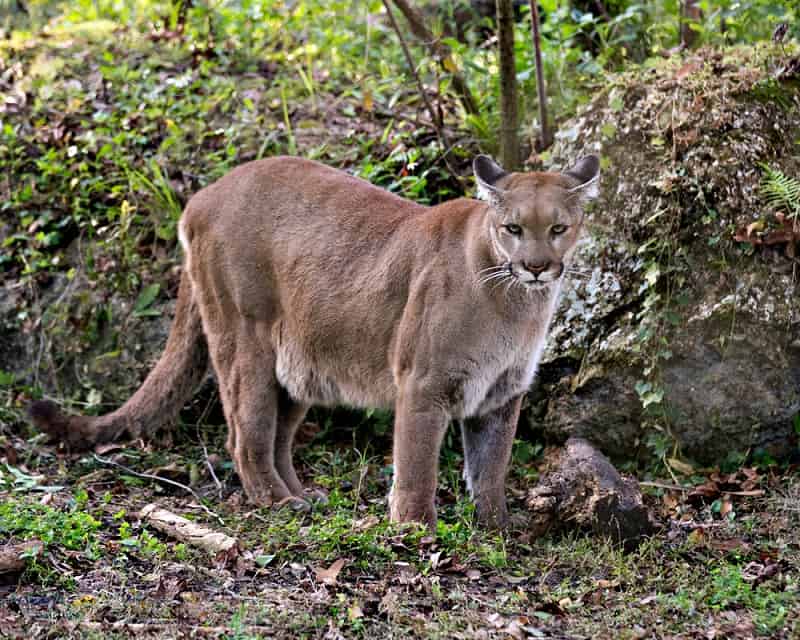
Florida Panther
The mountain lions that once called Alabama home are the same Florida panthers that now live in less than 5% of their former range in southern Florida.
Before European settlers populated the eastern U.S., the range of the Florida panther extended through the states of Florida, Georgia, Alabama, Mississippi, Louisiana, and Arkansas. They also ranged through parts of Tennessee and South Carolina. See
As the region became more densely populated, people began to view the cougar as a threat to livestock and a detriment to wild game populations. Many local governments placed a bounty on mountain lions.
Overhunting, coupled with habitat loss and overhunting of their main prey animal, the white-tailed deer, drove the Mountain lion to extinction in the eastern United States with the exception of an extremely small population of panthers in south Florida.
Taxonomic classification of Florida panthers
These cats were designated a distinct cougar sub-species with the scientific name, (Puma concolor coryi) by the American zoologist Outram Bangs, in 1899. However, mitochondrial DNA analysis performed in 2006 showed that many of the subspecies of cougar described in the 19th century were too closely related to be considered distinct subspecies. At that time, Florida Panthers received the scientific sub name, North American cougar or (Puma concolor couguar). Subsequently, in 2017, the Cat Classification Taskforce of the Cat Specialist Group reclassified all North American mountain lion populations into the subclass (Puma concolor couguar). See
What do mountain lions eat?
Mountain lions are opportunistic predators that hunt mostly nocturnally, stalking their prey, mainly deer, from behind. In Alabama, this would be a white-tailed deer.
On average, a mountain lion kills a deer once a week. Additionally, they consume coyotes, raccoons, birds, rats, feral pigs, porcupines, skunks, snakes, small pets, domestic livestock, and literally any other native wild animal they can catch.
Do mountain lions ever harm humans?
I’ve taken much of the following section from another one of my blog posts entitled “Are Mountain Lions Dangerous?” Found here.
Fatal mountain lion attacks on humans are extremely rare. In fact, there are only 20 records of fatal mountain lion attacks on humans in all of North America in the last 100 years. Don’t let that fact lull you into a complete sense of false security, though. There have been many more mountain lion attacks over the years that didn’t result in a fatality. Mountain lions are, in fact, dangerous.
A mountain lion is a formidably tough wild predatory animal. They can run 40 to 50 miles per hour for short bursts. Additionally, they can leap 18 feet vertically and 40 feet horizontally to catch their prey. These ninja-like predators typically stalk their prey from behind and then leap on an animal’s back. They then crush their cervical spine or larynx with their powerful jaws. They have a bite force of 750 pounds per square inch.
Some factors that cause mountain lions to attack humans
The majority of the time, mountain lions use their ghost-like skills to avoid human contact. On rare occasions, though, they attack humans. Below are a few of the reasons why.
- If the cougar has an injury or some sort of impairment that prevents it from killing its normal prey, it’ll be more likely to look at a person as potential prey.
- Male mountain lions engage in fights for territory. Some of their battles are to the death. A percentage of cougar attacks on humans are perpetrated by hungry semi-juvenile toms that have been kicked out of territories with a more abundant food supply.
- Scientific data suggests that mountain lions that were orphaned at a young age are more likely to attack humans. This is possibly because they missed the part of their training where their mothers taught them that humans are to be feared.
If a mountain lion is stalking you
- Never run away. According to a Multidisciplinary Journal of the Interactions of People and Animals, those who try to run away when they encounter a mountain lion put themselves at greater risk of sustaining serious injuries and even death. Running away triggers a lion’s instinct to chase.
- Stay as calm as you can. Panic is your enemy. In a survival situation such as this, a cool head will put you at a better advantage.
- Speak firmly in a loud voice but avoid a high-pitched tone or screaming
- You need to hold your ground when the cat is coming towards you and slowly back away when it pauses its approach
- Stand upright. Avoid bending over or crouching down as much as possible, as this puts you in the vulnerable position of appearing like a small, four-legged animal that can easily become prey.
- Open your jacket if you’re wearing one to appear larger. and wave your arms slowly to give yourself the appearance of having as much size as possible as you back away slowly. You can also throw rocks, sticks, or other objects at the lion.
- If you’re walking with a child, pick them up and hold them in your arms.
If you’ve done all the above, there’s still that small chance that you’ll still be attacked by the mountain lion. You need to be mentally prepared for this. At this point, do not panic and freeze up. In order to survive, you’ll need to fight back with as much aggression as you can muster.
Historical accounts show that people have successfully fought mountain lions off with their bare hands, sticks, rocks, garden tools, or any other weapon within reach. You already have a ready-made weapon if you’re using a walking stick. Target sensitive areas such as the eyes and nose, and hit as hard as you can! You should also try to remain standing if possible. You’ll lose some of your advantage on the ground. If you get knocked down, try as hard as possible to protect your neck and head as you continue to fight back.
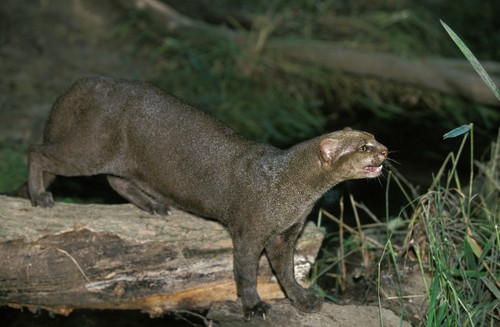
Jaguarundi in Alabama?
The Jaguarundi (Herpailurus yagouaroundi) is a small wild cat that is native to all 3 American continents. These feline predators reach about 22 pounds in weight with a total length of 3½ to 4 feet and stand about 11 inches at the shoulder when they’re fully grown. They have short legs in proportion to the length of their bodies and long tapered tails. This gives them a long sleek appearance. They also have a broader forehead than most felines and small rounded ears. This gives them the appearance of an animal from the Mustelidae or weasel family rather than a cat.
Jaguarundis show three different color phases, which are brownish-grey, blackish, and reddish-brown.
Most of the time, you can tell the habitat this cat comes from by the color of its coat. For instance, if it’s grey or dark, it is said to live in a dense forest that is mostly wet, while the red coat color is found in a jaguarundi cat that lives in a dry open habitat. A black jaguarundi, on the other hand, lives in the rainforest. Note that these are general rules, and you can find all these color phases in all environments.
The jaguarundi predominantly lives in South and Central America. However, they do range as far north as northern Mexico. They were formerly distributed throughout southwestern Louisiana and coastal Texas and may have ranged as far east, along coastal areas, as the Florida Panhandle.
There have been unconfirmed sightings of Jaguarundis in both Florida and Coastal Alabama. The jaguarundi sightings in Florida are thought to be the result of an individual releasing jaguarundis in multiple locations throughout the state. Although there are occasional Jaguarundi sightings in Alabama, they are not considered to be native cats.
There is thought to still be a small breeding population of Jaguarundis in southern Texas. However, sightings of these small cats are very rare. The last confirmed jaguarundi sighting in Texas was in 1986, when one was struck and killed by a vehicle.
Are there black panthers in Alabama?
Alabama wildlife officials routinely receive reports of large black cats. However, they maintain that there are no black panthers in the state of Alabama. As far as wildlife biologists know, Alabama doesn’t have any native black cats unless there are some extremely rare melanistic bobcats in the state. There’s never been a documented case of a black mountain lion.
The times that people report sightings of black panthers to Alabama wildlife officials are often cases of mistaken identity. Small black bears, river otters, fishers, and black Labradors all have dark brown or black fur and can be mistaken for black panthers if the lighting is bad.
When people talk about a black panther, they’re actually talking about either a black leopard or a black jaguar. See, Leopards are native to Africa and Asia.
On the other hand, Jaguars are native to South America, Central America, and North America. They are occasionally spotted in the American desert southwest. This is the closest to Alabama that one has seen in recent years though.
Recent Posts
The only venomous snakes in Washington State are Northern Pacific Rattlesnakes. The Northern Pacific Rattlesnake (Crotalus oreganus oreganus) is a sub-species of the Western Rattlesnake. Anyone...
Skunks are not classified as true hibernators. But they go into a state of torpor when the weather gets cold. Skunks are light sleep hibernators, along with opossums, bears, and raccoons. ...

